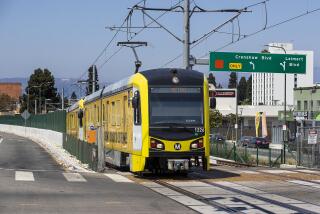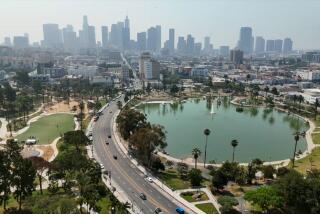Study Cites Gas Hazard Along New Rail Route
Studies released Tuesday of proposed Westside Metro Rail routes identified a new area with high readings of underground methane gas and concluded that the potential savings from an above-ground alignment would be less than predicted earlier.
The report, part of a continuing effort to select a new route that would connect a proposed downtown Los Angeles segment of the subway with Hollywood, the Wilshire District and the San Fernando Valley, offered the first information on cost, ridership and potential geologic conditions for four routes selected for detailed study.
The rerouting was ordered by Congress last year at the urging of Rep. Henry Waxman (D-Los Angeles) to avoid tunneling through an area of potentially hazardous underground gas identified in the wake of a Fairfax-area clothing store explosion.
Pattern of Routes
Three of the routes being studied by the Southern California Rapid Transit District form a wishbone around the hazardous area. In all three cases, a subway line would travel north on either Vermont or Western avenues from Wilshire Boulevard. From each of those routes, a branch subway line would extend south down Crenshaw Boulevard and west on San Vicente Boulevard.
The fourth route includes an aerial segment west along Wilshire Boulevard over the gassy area, and another aerial segment north on Vermont toward Hollywood.
New probes found high readings of methane gas along Crenshaw and San Vicente boulevards. While those readings are among the highest found, RTD officials said they did not pose a major hazard because the gas is under minimal pressure. “We’re still of the opinion that any of these can be constructed safely,” said Al Perdon, RTD’s assistant general manager.
A saving of up to $800 million initially anticipated from the aerial option was reported on Tuesday to be only about $300 million. Perdon said additional engineering and predicted right-of-way acquisition costs led to the lower estimate.
Still, the aerial option is the cheapest of the four--$2.9 billion in 1985 dollars compared to as much as $3.25 billion for the most expensive subway alternative.
Gary Russell, vice president of the Wilshire Chamber of Commerce, which wants an aerial route on Wilshire, said the potential savings with that option has been diminished. He said the whole system outside of downtown should be aerial.
Objection to Appearance
However, Bill Christopher, a spokesman for the Miracle Mile Residential Assn., said his group believes the new reports are steering toward selection of the aerial option, which the association strongly opposes because of its appearance. “They all run into gas problems, and the (aerial route) will turn out to be cheaper.”
Because the aerial route would allow the line to be built on Wilshire Boulevard, it is ranked highest for compatibility with the city’s development plans. It would serve seven major commercial centers, while the subway alternatives would each serve just four or five.
All four routes would attract fewer riders than the 360,000 a day projected for the previous subway route under Wilshire Boulevard and Fairfax Avenue. However, on one route that would travel west through much of Hollywood before tunneling through the Santa Monica Mountains to the Valley, the projected ridership was only slightly less than that.
The reports were presented at community meetings Tuesday. The RTD staff will recommend its preferred route next month.
More to Read
Sign up for Essential California
The most important California stories and recommendations in your inbox every morning.
You may occasionally receive promotional content from the Los Angeles Times.










